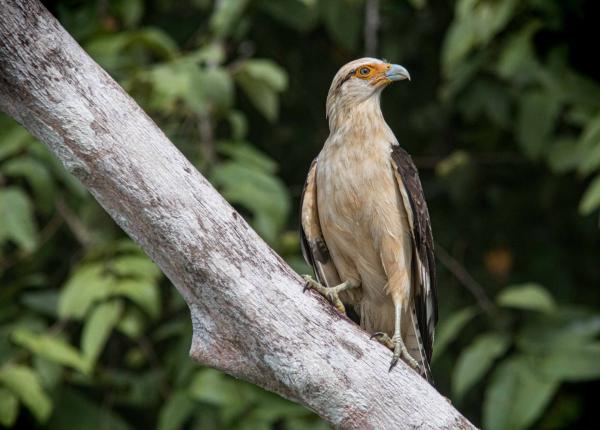Did You Know?
- The Yellow-headed Caracara has been known to glean ticks and other insects from the backs of cows, tapirs, capybara, and even an iguana!
- There are two recognized subspecies of the Yellow-headed Caracara
- This species is one of a few raptors that has been documented feeding on fruit!
How The Peregrine Fund is Helping
Though The Peregrine Fund does not work directly with Yellow-headed Caracaras, our efforts in scientific research, habitat conservation, education, and community development help conserve birds of prey around the world. We also supply literature to researchers from our avian research library, which helps scientists around the world gather and share important information on raptor conservation. Our work with the Neotropical Raptor Network helps conserve raptors by fostering collaboration and communication among raptor enthusiasts in the region. And, finally, our support of the Global Raptor Information Network gives raptor researchers tools to more efficiently conduct their own studies while contributing to a global program. It also provides citizen scientists a way to participate in raptor science and conservation.
Where They Live
The Yellow-headed Caracara is a Neotropical species.It is found from Costa Rica south through Panama, northern South America, all the way to northern Argentina and Uruguay.
Despite its presence in the neotropics, it might be easy to imagine this raptor living deep within dense neotropical forests. However, this falcon actually prefers open country such as savannas, cattle pastures, agricultural lands, and riparian areas. It spends a lot of time near roads, as well, where it searches for roadkill. If you are in Yellow-headed Caracara territory, be sure to scan low branches and even look on the ground for this species!
What They Do
True to its name, the Yellow-headed Caracara has a pale yellowish head. It has a beautiful dark eyestripe, and a dark brown back and wings which contrast nicely with its creamy head and breast. Juveniles tend to be dark brown all over. If you are in a place where Yellow-headed Caracaras are found, be sure to keep your eyes and your ears open as well. These falcons tend to be very vocal, often making loud wails, which are unmistakeable. This caracara is a diurnal species and does not migrate.
Why They Need Our Help
This species is quite common throughout its range, which may in fact, be expanding. Deforestation in some areas has provided new habitat for these falcons. It is categorized as a species of "Least Concern" which means conservationists don't believe this species will suffer any declines in the foreseeable future.
What They Eat
These raptors are known as "dietary opportunists" which means they will feed on pretty much anything they can capture, kill, or find. They will eat carrion (animals that are already dead) including roadkill, as well as garbage, dung, and small live animals, including mammals, snakes, lizards, fish, crabs, large insects, caterpillars, young chickens, and the nestlings from bird nests.
Compared to other raptors, the Yellow-headed Caracara is not considered to be particularly strong or swift. While it will sometimes stoop after prey while in flight, it tends to prefer to hunts on the ground, and it sometimes pirates (or steals) food from other scavengers, such as vultures by mobbing them until they drop their food. This caracara also spends time among cattle, making dashes after small prey, and also frequents grass fires to capture animals fleeing from the smoke and the flames.
Nests, Eggs, and Young
The Yellow-headed Caracara lays its eggs in a stick nest, very often high in tree, including palm trees. In areas where there aren't enough adequate trees for nesting, it may lay its eggs on mounds or brushy thistles. It has also been documented nesting in buckets, or other similar objects that are hung along the walls of a house!
Females may lay from 1–4 eggs. Like in many other falcon species, the females will do the majority of incubating the eggs. She must do this for around 22 days. After the nestlings hatch, they will fly from the nest for the first time when they are around 18 days old. After the nestlings fly for the first time, they will remain in their parents' territory for around 3 weeks as they learn to hunt, avoid danger, and generally survive on their own.
Yellow-headed Caracara and the World Center for Birds of Prey
The World Center for Birds of Prey offers fun ways to learn about birds of prey. The visitor center offers interactive displays, tours, interesting videos and a children's room with activities from coloring sheets to quizzes to costumes and a touch table for the curious mind. We also have many different birds of prey on display year-round. Knowledgeable staff and volunteers are on hand to answer any questions you may have about Yellow-headed Caracara or any other bird of prey.
References:
Bierregaard, R. O., G. M. Kirwan, P. F. D. Boesman, and J. S. Marks (2020). Yellow-headed Caracara (Milvago chimachima), version 1.0. In Birds of the World (J. del Hoyo, A. Elliott, J. Sargatal, D. A. Christie, and E. de Juana, Editors). Cornell Lab of Ornithology, Ithaca, NY, USA. https://doi.org/10.2173/bow.yehcar1.01
Global Raptor Information Network. 2021. Species account: Yellow-headed Caracara Milvago chimachima. Downloaded from http://www.globalraptors.org on 29 Nov. 2021
Pacheco, M.P. and A. L. Saborío. 2018. Symbiotic behavior between Milvago chimachima and Iguana iguana in Pavones, Costa Rica. Spizaetus: The Neotropical Raptor Newsletter. Issue 26. pp.2-4.









